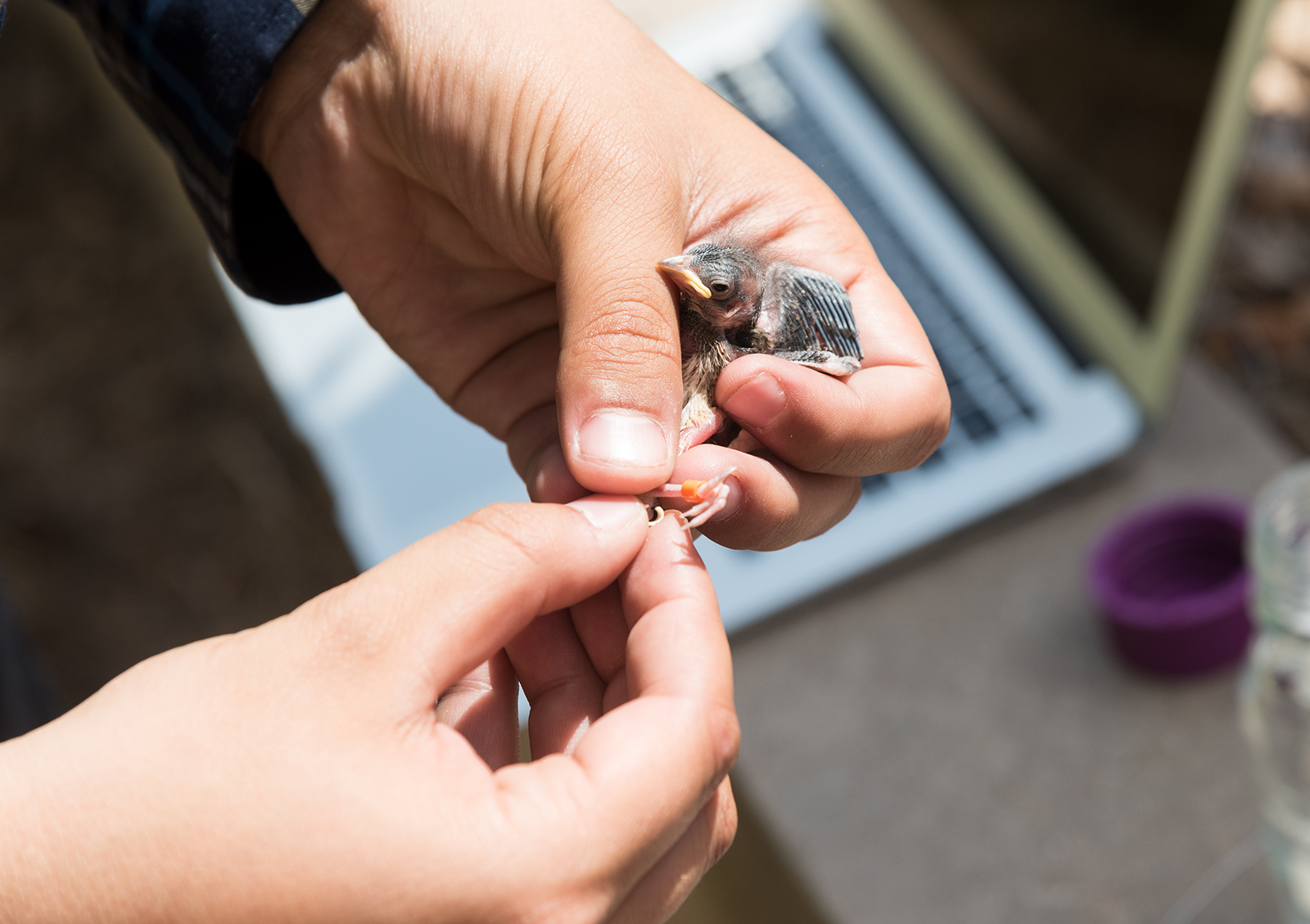Student researchers study urban effects on UCLA’s dark-eyed juncos

UCLA researchers tag baby junco birds to monitor the species’ behavior and genetics. (Daniel Leibowitz/Daily Bruin staff)
By Emi Nakahara
June 6, 2018 11:16 p.m.
Three student researchers crouched across from the Evelyn and Mo Ostin Music Center, cradling baby birds roughly the size of a large peanut.
“They’re opening their mouths; they must be hungry,” said Ellie Diamant, a graduate student in biology. “Sometimes they can get annoyed, pass out, poop or vocalize, but we try to minimize their stress as much as possible.”
Diamant is part of the Yeh Lab, which analyzes the Southern Californian populations of dark-eyed juncos, a bird species native to the mountainous regions of North America. From March to August, the adult juncos nesting across UCLA’s campus care for their recently hatched young, whose genetics and behavior will be analyzed and monitored by the researchers in the Yeh Lab.
“What’s most interesting about juncos is the fact that they’ve successfully colonized urban environments,” Diamant said. “It’s a success story of evolution.”
To process nests, Diamant and Sam Bressler, another graduate student in biology, carefully attach unique three-color combination tags to the legs of junco chicks, take blood and fecal samples and record their body masses.
Diamant said she studies how juncos have adapted to urban environments and how natural selection is changing their population’s genetics. The blood and fecal samples from the chicks contain their DNA for genomic analysis, she said.
Bressler studies the gut microbiota of juncos to determine whether antibiotic-resistant bacteria living within the bodies of juncos affects their ability to survive and pass on their genes to offspring. The fecal samples collected contain bacteria living in the digestive systems of the juncos, which Bressler analyzes.
Pamela Yeh, an assistant professor of ecology and evolutionary biology who runs the lab, said she studied the junco population that lives at UC San Diego when she was an undergraduate student there and wanted to expand the research to the population at UCLA. As more juncos have settled in an urban campus setting, she said she and her students have noticed various behavioral changes.
One behavioral change is the extension of their breeding season, Yeh said. While juncos in their native habitat breed for one to two months up until May, juncos at UCLA breed for seven to eight months from late winter until August. The direct cause is not known, but Yeh said she thinks the change may be due to a milder climate and greater number of insects in the regularly watered lawns.
However, long breeding seasons are taking a toll on the female juncos’ health.
“(The females) look miserable and ragged, which are the consequences of spending so much energy on reproduction,” Yeh said. “They’ve been digging in the lawn for insects for so long that the feathers near their beaks are gone.”
Another behavioral change is the location of their nests. Juncos make nests on the ground in their native habitat. However, at UCLA and in other urban areas, roughly a third of the juncos have built nests above the ground, most likely because of a lack of grass and shrubbery, as well as to avoid people and predators, Yeh added.
“It can be challenging for them in urban spaces,” Yeh said. “People step on the nests and bring with them predators like cats and rats.”
Predation is the largest common concern for juncos, especially when they are young, Diamant said.
“It’s unfortunate, but baby birds are like the popcorn of the ecosystem,” she said. “Almost any carnivore or omnivore will eat them, including the squirrels.”
To hide from predators, juncos nest in well-hidden areas on campus, such as the corners of windows or within vine-covered walls, and sometimes in unexpected places such as a construction worker’s hat inside an underground parking lot, Bressler said.
“Junco behaviors are very plastic,” Diamant said. “They can change their behaviors readily in order to survive and adapt.”
Sharanniyan Ragavan, a first-year microbiology, immunology and molecular genetics student in the Yeh Lab, said undergraduate members in the lab search for junco nests around campus. He added while they can be difficult to see, the nests are located in places all over campus, such as Murphy Hall, the Franklin D. Murphy Sculpture Garden, the Hill and the Ronald Reagan UCLA Medical Center.
However, Diamant said students should avoid disturbing nests if they find them, especially if the parent juncos are present. Too much disturbance can lead the parents to prematurely abandon the nest, making it difficult for the chicks to survive, she said. Parent juncos are also territorial and protective of their nest, Bressler said, and can confront researchers when they try to approach it.
Bressler said a junco couple named the Haydns nesting nearby the Schoenberg Hall often charge at him and chirp loudly when he approaches the nest, so he takes extra caution.
Despite difficulties in collecting data from juncos at times, Yeh said she hopes students on campus can appreciate their presence and participate in scientific thinking by observing the juncos’ interesting behaviors on their own.
“We’re doing community science work, because you can see what’s going on right here on campus,” Yeh said. “If any (student) sees a junco, that’s an opportunity to get them involved.”


